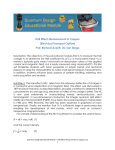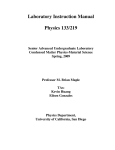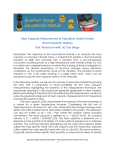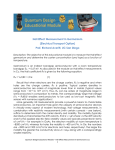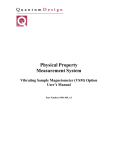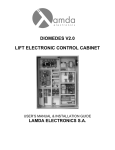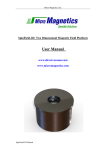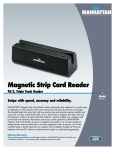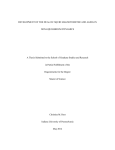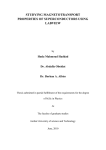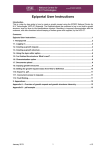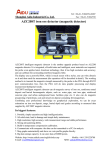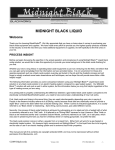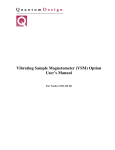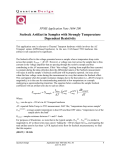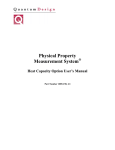Download This Experiment! - Quantum Design Education
Transcript
Magnetic Properties of a Paper Clip (Vibrating Sample Magnetometry Option) Prof. Richard Averitt, UC San Diego Description: The objective of this educational module is to introduce the basic measurement capabilities of the VersaLab Vibrating Sample Magnetometry (VSM) Option. A simple isothermal magnetization measurement on a piece of a paper clip will be performed. Vibrating Sample Magnetometry: Magnetism has a rich history that can be traced back to the observation of permanently magnetized materials such as lodestone (otherwise know as magnetite Fe3O4) and iron. It was realized that magnetic materials were of practical use with navigation being one early example. With the development of electromagnetism in the 19th century and quantum mechanics in the 20th century, great strides were made in the understanding the origin of magnetism and creating functional magnetic materials for applications that range from data storage and magnetic resonance imaging [1-4]. Despite these advances, magnetism remains at the forefront of condensed matter physics. The field of “spintronics” seeks to create devices for computing and information processing using the spin (rather than the charge) of electrons. In correlated electron materials, spin plays a crucial role. For example, the undoped parent compounds of high-Tc cuprate superconductors are antiferromagnetic Mott insulators, leading to speculation that antiferromagnetic spin fluctuations might play a role as the “glue” needed to create Cooper-pairs. Quantum Design Educational Module – Magnetometry on a Paper Clip (v.1) 1 Figure 1: magnetized paper clips These advances in fundamental and applied magnetism are impressive. Nonetheless, there is still something magical about magnetism when playing with permanent magnets. For example, many a child has noticed that metal objects that have come into contact with a permanent magnet become magnetized. Figure 1 shows paper clips that have become magnetized after being in contact with a Nd-Fe-B magnet. The resultant magnetism is weak and fragile but as the figure shows, the observed effects are remarkable. This remnant ferromagnetism arises from iron and nickel in the paper clips, but many questions remain. To increase our understanding, we need to be able to perform quantitative measurements. This educational module aims to provide introductory answers to the following questions. What do we experimentally measure to characterize magnetic materials? How are these measurements performed? We refer the readers to standard textbooks that address these questions in considerable detail [1-4]. Our approach will be from a practical point-of-view, and we assume exposure to these ideas at the level of the textbook by Kittel [3]. In characterizing the magnetic properties of materials, one important quantity is the temperature dependence of the magnetic response. We know that with increasing temperature, a ferromagnet will eventually become nonmagnetic. That is, above the Curie temperature (Tc) the material is paramagnetic while below this temperature, the sample is ferromagnetic. As examples, Tc for Fe is 1043K, Ni is 627K, and Gd is 292K. In the paramagnetic phase, there are unpaired electron spins that are thermally fluctuating. An applied magnetic field can orient these spins, but upon removal of the field thermal fluctuations dominate and the there is no permanent magnetic moment. However, below Tc exchange interactions between spins result in the formation of domains where the spins are aligned even in the absence of a magnetic field. Upon applying a Quantum Design Educational Module – Magnetometry on a Paper Clip (v.1) 2 field, domain wall motion and rotation leads to an increase in the magnetization. That is, the sample has become magnetized. Above, Tc the magnetic susceptibility χ can be measured. The Curie-Weiss law provides a mean field description of this response: 𝜒𝜒 ≡ 𝑀𝑀 𝐻𝐻 𝐶𝐶 = 𝑇𝑇−𝑇𝑇 𝑐𝑐 Eqn. 1 where M is the magnetization, H the magnetic field, and C the Curie-Weiss constant. Eqn. 1 is the volume susceptibility and is dimensionless. It is also common to see mass susceptibility, which is the volume susceptibility per unit mass, or the molar susceptibility, which is the volume susceptibility per mol. As shown in Figure 2a, a plot of χ-1 is linear and intersects the x-axis at Tc. As the name implies, χ is a measure of how susceptible the spins are to alignment by a field. It diverges at Tc, meaning that thermal fluctuations are less effective in preventing the spins from aligning. At Tc a phase transition occurs, and the material becomes ferromagnetic. Below, Tc the magnetization M is the quantity of interest. As shown in Fig. 2a, it increases with decreasing temperature. M is the number of magnetic dipoles per unit volume. It is common to see M presented in cgs units -- erg/(Oe cm3) where convention is that erg/Oe is simply written as emu, giving units of emu/cm3. Further, the specific magnetization is often quoted in the literature and has units of emu/gm. In MKS units, M has units of Am-1, with the specific magnetization of Am-1/kg. Figure 2: a.) Magnetic response vs. temperature for a ferromagnet. b.) sketch of a magnetization curve. Ms is the saturation magnetization. Point a defines the remanent magnetization and point b the coercive field. At a given temperature, M can be measured as a function of field as sketched in Fig. 2b. This is a hysteresis curve. There is a great deal of information in these curves. With increasing field, the magnetization saturates to a value Ms. The remanent magnetization (labeled a in the curve) is the magnetization that remains at zero applied field and characterizes the strength of permanent magnets. The coercive field (point b on the curve) is a measure of the field Quantum Design Educational Module – Magnetometry on a Paper Clip (v.1) 3 strength required to decrease M to zero. Hard magnetic materials (such as permanent magnets) have a high coercive field (greater than ~500 Oe), while soft magnets (used in transformers) have a small coercive field (~10 Oe or less). Further details can be found in [4,5]. The next question we address is how are hysteresis loops or magnetic susceptibilities measured? There are many techniques (see chapter 3 of [5]) – a common approach is based on Faraday’s law. That is, changes in the magnetic flux will produce a measureable voltage. In the case of vibrating sample magnetometry (VSM), the sample is placed between detection coils. Sinusoidal motion of the sample results in an oscillating voltage in the detection coils (arising from flux changes) that can be measured using lock-in amplifier based detection. Figure 3 is a schematic of a VSM. Figure 3: VSM schematic, modified from [6]. The sample is on a rod that is driven by a speaker. The sample (detection) coils detect the change in magnetic flux. The VersaLab is a modern version of what is shown in Fig. 3. For example, a speaker is not used to vibrate the sample. Rather, a computer-controlled motor with a linear encoder is used, but the basic principle is the same. With sinusoidal motion, the voltage is given as 𝑉𝑉 = − 𝑑𝑑Φ 𝑑𝑑𝑑𝑑 = 𝐶𝐶𝐶𝐶𝐶𝐶𝐶𝐶 sin( 𝜔𝜔𝜔𝜔) Eqn. 2 where Φ is the magnetic flux, C is a coupling constant, A is the vibration amplitude, ω is the frequency and m is the sample moment. With proper calibration it is then possible to measure m, which has units of emu in cgs and Am2 in MKS. As an additional practical issue, we note that VSM measurements are Quantum Design Educational Module – Magnetometry on a Paper Clip (v.1) 4 “open circuit.” That is, lines of flux are external to the sample, leading to a demagnetizing field. Demagnetizing fields are strongly dependent on the sample geometry and play an important role in the properties of permanent magnets, and must be accounted for when characterizing the properties of ferromagnets. A detailed discussion can be found in sections 2.7 to 2.9 of [4] or section 2.4 of [5]. In short, VSM provides the means to measure the DC susceptibility and can measure diamagnetic, paramagnetic, ferromagnetic, and antiferromagnetic materials. It has a sensitivity of ~10-6 emu and can perform measurements as a function of temperature and magnetic field to provide data similar to what is schematically shown in Figure 2. In the following, we will perform an isothermal MH measurement on a piece of a paper clip. Notes: 1. Steven H. Simon, The Oxford Solid State Basics, Oxford University Press, Oxford, 2013. See especially Chapters 19-23. 2. David L. Sidebottom, Fundamentals of Condensed Matter and Crystalline Physics, Cambridge University Press, Cambridge, 2012. Chapter 15. 3. C. Kittel, Introduction to Solid State Physics, 7th edition, J Wiley, New York, 1996. Chapters 14 -16. 4. B. D. Cullity and C. D. Graham, Introduction to Magnetic Materials, 2nd edition, IEEE Press, New Jersey, 2008. This book presents an important and detailed practical perspective on magnetism in contrast to typical condensed matter books which tend to focus on phenomena to the detriment of practicalities. 5. D. Jiles, Introduction to Magnetism and Magnetic Materials, 2nd edition, Taylor and Francis, Boca Raton, 1998. 6. S. Foner, J. Appl. Phys. 79, 4740 (1996), review of VSM by pioneer of this technique. Instructions: In this section, we describe the process to measure the M-H curve for a piece of a paper clip. Before proceeding with these measurements, it is important to read through the VSM user’s manual. Several items are needed for this experiment, which includes: • • • • • Paper clips Wire cutters Non-magnetic adhesive (see section 3.3 of the VSM user’s manual) We will use zircar cement below The palladium calibration standard that comes with the VSM kit A brass sample holder for mounting the sample Quantum Design Educational Module – Magnetometry on a Paper Clip (v.1) 5 • • • • A scale to measure the mass of your sample A VSM sample mounting station Tweezers Toothpick a.) First, the various components of the VSM need to be installed into the VersaLab. The puck for the VSM contains the detection coils as shown in Fig. 4. On the right side is a cross-section view showing the lower and upper detection coils as well as the sample indicated in red. Figure 4: Coilset puck b.) Install the coilset puck as shown in Figure 5. Quantum Design Educational Module – Magnetometry on a Paper Clip (v.1) 6 Figure 5: Installing the Coilset puck. c.) Following the insertion of the coilset puck, the guide tube should be inserted into the VersaLab as shown in Figure 6. Figure 6: Inserting the guide tube. d.) Next the VSM head should be installed and clamped into place. This must be done very carefully since the head is quite heavy. Note: the VSM head should always remain vertical! Figure 7 shows the installed VSM head. The control head electronics should also be plugged in as shown in Figure 8. The cable for the VSM module electronics should also be inserted. Quantum Design Educational Module – Magnetometry on a Paper Clip (v.1) 7 Figure 7: VSM Installed on the VersaLab. Note: the black cap on top can be removed and this is where the sample rod is inserted. Figure 8: control cable plugged into VSM head. e.) After installing the VSM hardware components, the VSM option should be activated in MultiVu. f.) The VersaLab comes with a palladium calibration standard that has been permanently attached to a brass sample holder using GE varnish. Figure 9 Quantum Design Educational Module – Magnetometry on a Paper Clip (v.1) 8 shows the Pd sample/holder sitting in the sample mounting station. The close up in Figure 10 shows that the sample is located at ~34mm from the end of the sample paddle. This will allow for easy centering of the sample between the coils in the coilset puck. This value (34 mm) known as the sample offset will be needed later so it should be recorded. Figure 9: Pd standard on brass sample holder in mounting station. Figure 10: Close up view of Pd standard. g.) Install the Pd sample holder on the end of the sample rod as shown in Figure 11. It is easily screwed on. Quantum Design Educational Module – Magnetometry on a Paper Clip (v.1) 9 Figure 11: Sample paddle attached to the sample rod. h.) Remove the black cap from the VSM head and carefully insert the sample rod into the VersaLab as shown in Figure 12. When the sample rod is fully inserted you will feel a slight tug since there are small magnets at the top of the sample rod that help to hold it in place (Fig. 13). i.) Place the black seal cap onto the VSM head. Figure 12: Inserting the sample rod into the VSM/VersaLab. Quantum Design Educational Module – Magnetometry on a Paper Clip (v.1) 10 Figure 13: Sample rod fully inserted. Prior to measurement, the black sample cap should be placed back on the VSM head. j.) With the palladium standard installed, a simple measurement can be performed. In MultiVu, use the Install/Remove Sample wizard on the Install tab of VSM control center, and refer to Section 4.3.3 of the VSM user’s manual. Create a data file for this Pd measurement. To center the sample, we could either apply a magnetic field (>1000 Oe) and scan to center the sample, or simply enter the sample offset manually. We will do the latter, using the value measured above (step f.) and (Fig. 10). Once the centering operation is complete, you will see a dialog box where you can select “close chamber” at which point the sample volume will be purged and evacuated such that the VSM is ready to perform measurements. k.) For the Pd calibration sample, there is no need to perform any sequencebased measurements. We will simply perform immediate-mode VSM measurements (see section 4.4 of the VSM user’s manual). The function of the Pd sample is calibration of magnetometer at 1 Tesla and 298 K. To get the expected moment, simply multiply the mass of palladium, the applied field and the susceptibility, which is 5.25x10-2 emu/gram-Tesla at 298 K. The expected moment at 1 Tesla for a 0.25 gram cylindrical shape is 0.013 emu. Set the temperature to 298K, and the field to 1 Tesla. In the VSM dialog box, set the VSM for continuous measuring. On the right side of the dialog box, the temperature, field, and moment will be displayed continuously in real time. As mentioned above a moment of about 0.013 emu should be obtained. Quantum Design Educational Module – Magnetometry on a Paper Clip (v.1) 11 l.) Once this is verified, the measurement can be stopped and the sample removed using the sample install wizard in order to prepare for measuring a piece of the paper clip. Please put the mounted Pd sample back in its protective tube, this standard sample must remain uncontaminated! m.) Unlike the pre-mounted Pd standard, the paper clip sample must be prepared. The first step is to cut off a small piece of the paper clip with wire cutters as shown in Fig. 14. This needs to be done with caution since the small piece can easily fly off in a random direction: cover the wire cutters with a tissue to contain the sample. Figure 14: Cutting the paper clip. n.) Measure the mass of the paper clip sample using a scale. o.) Place a small portion of adhesive (in this example we used Zircar since it was readily available) in a brass sample paddle using a toothpick as shown in Fig. 15. Quantum Design Educational Module – Magnetometry on a Paper Clip (v.1) 12 Figure 15: Zircar cement in brass sample holder. p.) Using tweezers, place the sample on the zircar cement as shown in Figure 16. Allow the sample to dry, and note the sample offset for the subsequent centering. Try to place the sample at ~35mm from the end of the paddle. Figure 16: Paper clip sample in brass sample paddle. q.) After the zircar cement dries, the sample can be loaded into the chamber as before. Once the centering touchdown operation is completed and the sample chamber is purged and evacuated, the VSM is ready for measurements. r.) Within MultiVu, it is quite simple to write sequences to perform temperature dependent magnetization measurements or isothermal magnetization measurements as a function of field. Chapter 6 of the VSM user’s manual provides a detailed description of the VSM software, and sections 6.7 to 6.9 are particularly useful. We will be performing a fivequadrant magnetization measurement so the sequence-mode “Moment vs. Field” command will be utilized (read section 6.8). By five-quadrant, the following is meant. The magnetization is measured a.) starting from Quantum Design Educational Module – Magnetometry on a Paper Clip (v.1) 13 zero field up to the largest positive field selected (quadrant 1); b.) from the largest positive field to the largest negative field (quadrant 2,3); c.) from the largest negative field back up to the largest positive field (quadrant 4,5). This five quadrant sweep corresponds to a complete hysteresis loop. s.) Set up sequence for a five-quadrant measurement. The measurement can be performed in continuous sweep. For an initial pass, choose 50 Oe/s covering from -5000 to 5000 Oe. After the sequence is saved, the measurement can be performed. You should obtain data similar to that in Figure 17. Figure 17: Sample data from paper clip. t.) From this rather broad sweep, it is possible to determine the saturated moment of the sample. However, it appears that the data passes through the origin for all of the sweeps. This would be at odds with the observed remanent magnetization that must be present such that the paper clips can attract one another as in Fig. 1. u.) Perform additional measurements to try to determine the remanent magnetization. For example, zooming in with higher precision steps near the origin may be useful. After you have finished your measurements you should answer the questions below. Questions: 1. In consideration of Fig. 1, use your data and knowledge about magnetization to discuss the nature of the magnetization in the paper Quantum Design Educational Module – Magnetometry on a Paper Clip (v.1) 14 clip. Is your data consistent with Figure 1? Do you need to take into account the demagnetizing field? If so, why? 2. Calculate your moment density (emu/gm) using the saturated moment. From looking in the literature (or online, in a book, etc.) how does this compare to the moment densities of well-known ferromagnets (e.g. Fe, Ni) and various permanent magnets? 3. Approximately how may spins are there in your sample? 4. The VSM moment sensitivity is 10-6 emu. If you had a 100 nm thick film of iron, what would the lateral dimensions need to be to, using VSM, be able to measure a moment of 10-5 emu? How many spins does this correspond to? 5. Read the following paper: C. D. Graham, “High-sensitivity magnetization measurements,” J. Mater. Sci. Tech. 16, 97 (2000). Write a summary describing the differences, advantages, disadvantages, etc. of VSM in comparison to the other techniques described in the paper. Answer the following questions. SQUID magnetometry is discussed in this paper. What is it sensitivity in emu? Is this better than VSM? What is the image effect, and why could it be a problem? 6. Write a paragraph (or two) describing the basic phenomenon of demagnetizing fields and discuss how this impacts measuring the intrinsic susceptibility or permeability of a sample. Quantum Design Educational Module – Magnetometry on a Paper Clip (v.1) 15
















